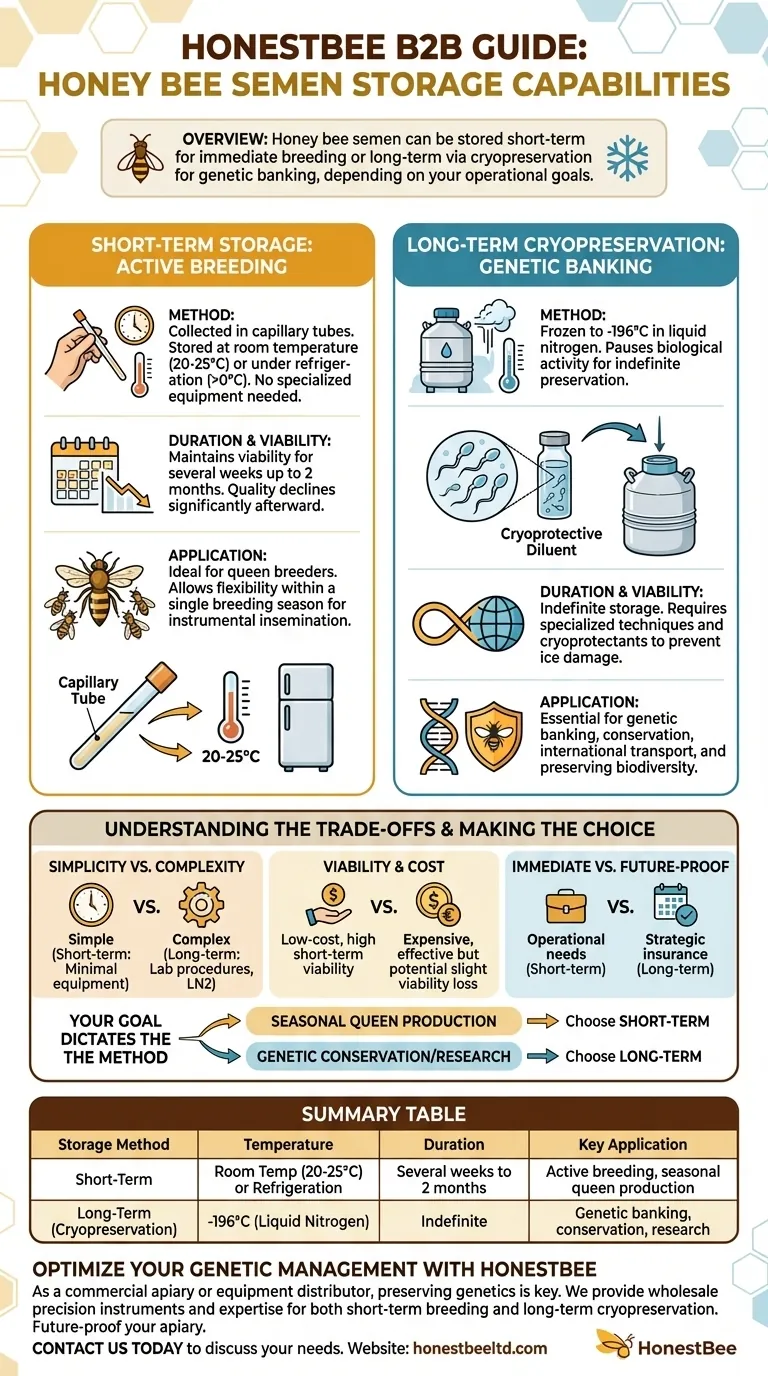In short, honey bee semen can be stored in two primary ways. For short-term needs, it can be kept viable for several weeks at room temperature or under refrigeration. For long-term genetic banking, semen is cryopreserved in liquid nitrogen at -196°C, which requires specialized techniques and cryoprotective agents to maintain viability indefinitely.
The method you choose for storing honey bee semen depends entirely on your goal. Short-term storage is a simple, practical solution for immediate breeding, while long-term cryopreservation is a complex but powerful tool for genetic conservation and future use.

Short-Term Storage: The Go-To for Active Breeding
Short-term storage is the most common and accessible method, designed for use within a single breeding season. It prioritizes simplicity and high viability for immediate instrumental insemination.
How It Works
Semen is collected in capillary tubes and can be stored at room temperature (around 20-25°C) or under refrigeration (above freezing). This method requires no specialized equipment beyond what is used for collection.
Duration and Viability
Viability is maintained for a period of several weeks up to two months. After this window, the quality and motility of the spermatozoa begin to decline significantly, impacting the success of insemination.
Primary Application
This technique is ideal for queen breeders who need to hold semen for a few days or weeks to coordinate inseminations. It allows for flexibility in timing without the complexity of deep freezing.
Long-Term Storage: Cryopreservation for Genetic Banking
Cryopreservation is a highly technical process for preserving genetic material indefinitely. It is the foundation of honey bee germplasm banks and long-term conservation efforts.
The Cryopreservation Process
The core of this method involves freezing the semen to -196°C in liquid nitrogen. At this temperature, all biological activity ceases, effectively pausing the aging process of the sperm cells.
The Critical Role of Cryoprotectants
Before freezing, the semen must be mixed with a cryoprotective diluent. These solutions act like a cellular antifreeze, preventing the formation of damaging ice crystals that would otherwise rupture the sperm cells during freezing and thawing.
Key Benefits
The primary advantage is indefinite storage. This allows for the creation of genetic banks to safeguard valuable drone lines, transport genetics safely across international borders, and preserve biodiversity for future generations.
Understanding the Trade-offs
Choosing a storage method involves balancing accessibility, cost, and long-term goals. Each approach has distinct advantages and limitations.
Simplicity vs. Complexity
Short-term, above-freezing storage is straightforward and can be performed with minimal training or equipment. Cryopreservation, however, is a complex laboratory procedure that requires specific expertise, protocols, and access to liquid nitrogen.
Viability and Cost
Short-term storage is very low-cost and generally maintains near-perfect viability within its effective window. Cryopreservation is significantly more expensive and, while effective, can result in a slight loss of viability upon thawing if not performed correctly.
Immediate Use vs. Future-Proofing
The fundamental trade-off is between immediate operational needs and long-term strategic goals. Short-term storage serves the "here and now," while cryopreservation serves as an insurance policy for the future of a genetic line.
Making the Right Choice for Your Goal
Your objective as a breeder, researcher, or conservationist will dictate the correct storage strategy.
- If your primary focus is seasonal queen production: Short-term, room-temperature storage provides all the flexibility and viability you need for instrumental insemination within a few weeks.
- If your primary focus is genetic conservation or research: Long-term cryopreservation is the only viable method for banking valuable drone germplasm for future use or study.
Ultimately, mastering these storage techniques empowers you to manage and preserve honey bee genetics with precision and foresight.
Summary Table:
| Storage Method | Temperature | Duration | Key Application |
|---|---|---|---|
| Short-Term | Room Temp (20-25°C) or Refrigeration | Several weeks to 2 months | Active breeding, seasonal queen production |
| Long-Term (Cryopreservation) | -196°C (Liquid Nitrogen) | Indefinite | Genetic banking, conservation, research |
Optimize Your Genetic Management with HONESTBEE
As a commercial apiary or beekeeping equipment distributor, preserving valuable genetics is key to your operation's success and resilience. Whether you need reliable supplies for short-term breeding or are exploring long-term cryopreservation strategies, HONESTBEE provides the wholesale-focused equipment and expertise to support your goals.
We supply durable, precision instruments for semen collection and storage, helping you maintain high viability rates and secure your genetic lines. Let us help you future-proof your apiary.
Contact our team today to discuss your specific needs and explore our range of beekeeping supplies.
Visual Guide

Related Products
- No Grafting Queen Rearing Kit: System for Royal Jelly Production and Queen Rearing
- Plastic Chinese Queen Grafting Tool for Bee Queen Rearing
- Professional 3-Bar Frame Grip with Integrated Hive Tool
- HONESTBEE Advanced Ergonomic Stainless Steel Hive Tool for Beekeeping
- Professional Dual-End Stainless Steel Hive Tool for Beekeeping
People Also Ask
- What is the timeline for queen breeding? A 28-Day Guide from Egg to Laying Queen
- What steps should be taken if a queen is lost? Save Your Queenless Hive Now
- What are the developmental periods for different bee castes? Master the 16, 21, and 24-Day Timelines for Hive Success
- What should be done once eggs are present in the comb box? A Guide to Maximizing Queen Rearing Success
- What are the signs that indicate a colony needs requeening? Protect Your Hive's Health and Productivity



















